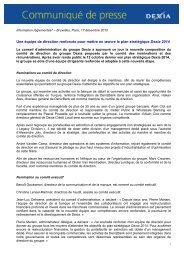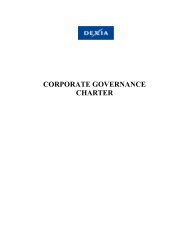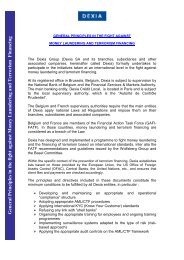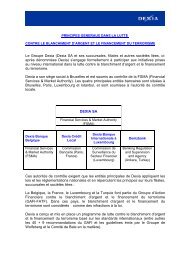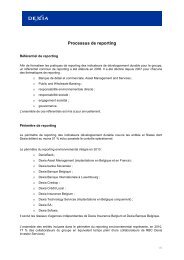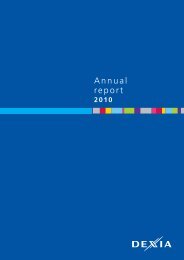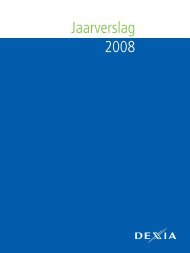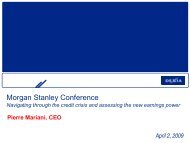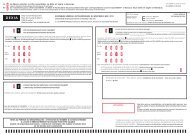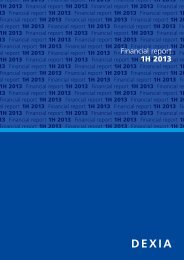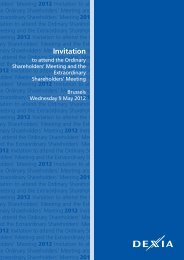Annual report 2009 - Dexia.com
Annual report 2009 - Dexia.com
Annual report 2009 - Dexia.com
- No tags were found...
Create successful ePaper yourself
Turn your PDF publications into a flip-book with our unique Google optimized e-Paper software.
Notes to the consolidated fi nancial statementshedged risk in the hedged item throughout the <strong>report</strong>ingperiod; and• the hedge is effective at inception and on an ongoingbasis.Entities of <strong>Dexia</strong> use internal derivative contracts (internalhedging) mainly to cover their interest-rate risk. Those internalcontracts are offset with external parties. If the contracts cannotbe offset with third parties, the hedging criteria are notmet. Internal derivative contracts between separate divisionswithin the same legal entity and between separate entitieswithin the consolidated group can qualify for hedge accountingin the consolidated financial statements only if the internalcontracts are offset by derivative contracts with a partyexternal to the consolidated group. In this case, the externalcontract is regarded as the hedging instrument.Changes in the fair value of derivatives that are designatedand qualify as fair value hedges and that prove to be highlyeffective in relation to hedged risk, are recorded in the statementof in<strong>com</strong>e, along with the corresponding change in fairvalue of the hedged assets or liabilities that is attributable tothat specific hedged risk.If the hedge no longer meets the criteria for hedgeaccounting (fair value hedge model), the adjustment tothe carrying amount of a hedged interest-bearing financialinstrument is amortised to net profit or loss over theperiod to maturity through an adjustment of the yield ofthe hedged item.Changes in the fair value of derivatives that are designatedand qualify as cash flow hedges and are highly effectivein relation to the hedged risk, are recognised in the hedgingreserve in equity as “Gains and losses not recognised inthe statement of in<strong>com</strong>e” (see ”Consolidated statement ofchanges in shareholders’ equity”). The non-effective portionof the changes in the fair value of the derivatives is recognisedin the statement of in<strong>com</strong>e. Where the forecast transactionresults in the recognition of a non-financial asset or aliability, the gains and losses previously deferred in equity aretransferred from equity and included in the initial measurementof the cost of the asset or liability. Otherwise, amountsdeferred in equity are transferred to the statement of in<strong>com</strong>eand classified as revenue or expense in the periods duringwhich the hedged firm <strong>com</strong>mitment or forecast transactionaffects the statement of in<strong>com</strong>e.Certain derivative transactions, while providing effective economichedges under <strong>Dexia</strong>’s risk management positions, donot qualify for hedge accounting under the specific rules inIFRS and are therefore treated as derivatives held for tradingwith fair value gains and losses <strong>report</strong>ed in in<strong>com</strong>e.1.19. Hedge of the interest-rate risk exposureof a portfolio<strong>Dexia</strong> has decided to apply IAS 39 as adopted by theEU because it better reflects the way <strong>Dexia</strong> manages itsactivities.The objective of the hedge relationships is to reduce the interest-raterisk exposure stemming from the selected categoryof assets or liabilities designated as the qualifying hedgeditems.The entity performs a global analysis of interest-rate risk exposure.It consists of assessing fixed rate exposure taking intoaccount all the exposure <strong>com</strong>ing from balance sheet andoff-balance-sheet items. This global analysis may excludecertain <strong>com</strong>ponents of the exposure, such as financial marketactivities, provided that the risk exposure stemming fromthe excluded activities are monitored on an activity-by-activitybasis. The entity selects assets and/or liabilities to be enteredinto the hedge of interest-rate risk exposure of the portfolio.The entity defines at inception the risk exposure to be hedged,the length of the time-bucket, the way and the frequency itperforms tests. The entity constantly applies the same methodologyfor selecting assets and liabilities entering in the portfolio.Assets and liabilities are included on a cumulative basisin all the time buckets of the portfolio. Hence, when they areremoved from the portfolio, they must be removed from allthe time buckets in which they had an impact.The entity may choose which assets and/or liabilities it wishesto classify into the portfolio provided they are included inthe global analysis. Demand deposits and savings accountsmay be included in the portfolio based on behavioural studyfor estimating expected maturity date. The entity may designateas qualifying hedged items different categories ofassets or liabilities such as available-for-sale assets or loanportfolios.The hedging instruments are a portfolio of derivatives. Sucha portfolio of derivatives may contain offsetting positions.The hedging items are recognised at its fair value (includingaccrued interest expense or in<strong>com</strong>e) with adjustmentsaccounted for in the statement of in<strong>com</strong>e.Effectiveness tests consist of verifying that the hedging objective,i.e. reducing the interest-rate risk exposure, is fulfilled.Inefficiency can <strong>com</strong>e only from over hedging due to noncontractualevents occurring within the categories of assetsor liabilities.Hedged interest-rate risk revaluation of elements carried outat amortised cost is included in the line “Fair value revaluationof portfolio hedges”.1.20. Day one profit or lossThe best evidence of the fair value of a derivative at initialrecognition is the transaction price (i.e., the fair value of theconsideration given or received) unless the fair value of thatinstrument is evidenced by <strong>com</strong>parison with other observablecurrent market transactions in the same instrument (i.e.,without modification or repackaging) or based on a valuationtechnique whose variables include only data from observablemarkets. The difference between the transaction price andthe fair value based on a valuation technique is <strong>com</strong>monlyreferred to as “Day 1 Profit or Loss”.Where the fair value is determined using validated valuationmodels for which all inputs are market observable, <strong>Dexia</strong>recognises the day one profits or losses at initial recognition inthe statement of in<strong>com</strong>e. Where such evidence does not exist,day one profit or loss is deferred and recognised in the statementof in<strong>com</strong>e to the extent that it arises from a change in a factor(including time) that market participants would consider in settinga price. The unrecognised amount of day one profit is amortisedover the remaining life of the transaction. If subsequently,the inputs be<strong>com</strong>e market observable, or when the instrumentis derecognised, the remaining amount of the deferred day oneprofit or loss is taken entirely in the statement of in<strong>com</strong>e.Management <strong>report</strong>Consolidatedfinancial statements<strong>Annual</strong> financial statementsAdditional information<strong>Annual</strong> <strong>report</strong> <strong>2009</strong> <strong>Dexia</strong> 115



